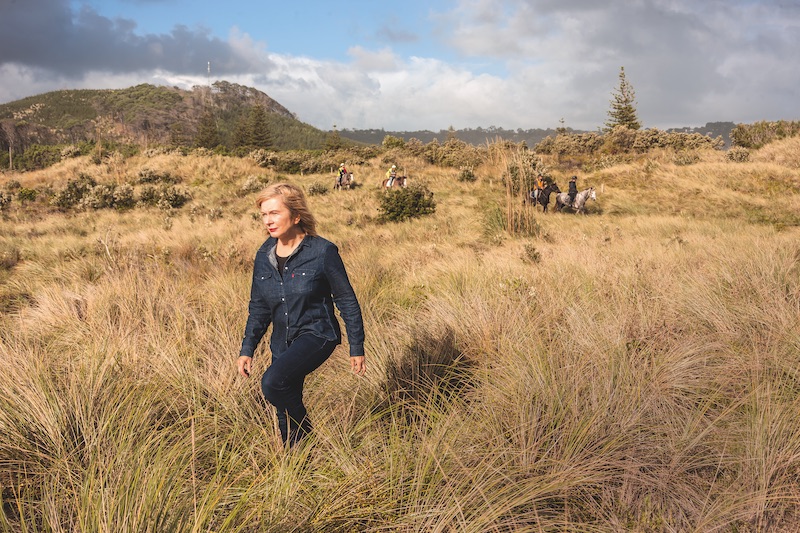Elizabeth Thomson: The Space In-Between
Elizabeth Thomson takes elements of the natural world and reimagines them as ambiguous geometric compositions.
Words: Mark Amery
Photography: Kallan Macleod
Interesting things happen when you get lost. The mind goes swimming when your eyes gaze on the play of light on water, leaves and rocks. As your field of reference dissolves the small can become big, and the big small. You’re in the surreal territory between things, where new possibilities and potential realities are opened up. It’s where life begins and ends. This is the mesmeric, sensual realm of Elizabeth Thomson’s art. For 30 years Thomson has been creating immersive sculptural reliefs in the space between nature and abstraction, art and science. Technically mindboggling, they extend our conception of what sculpture, photography and painting can be.
Thomson takes us into patterns that operate between nature and culture. In this, they are as alien as they are familiar.
“I’m interested in this concept that Louise Bourgeois mentions of being between memory and oblivion,” she says. “There are things I remember and I use that are familiar, and then there’s what you don’t remember, or what you can’t quite recall being oblivion. It’s the creative space in-between that I’m interested in. “
Represented by Dominik Mersch in Sydney, Page Blackie in Wellington, and Two Rooms in Auckland Thomson graduated with a Master of Fine Arts from Elam in Auckland in 1988. She moved to Wellington in 1991. We meet in her large studio in the suburb of Newtown.
An upcoming Two Rooms exhibition draws from memories (and their blurred edges) of growing up in Auckland’s Waitakere Ranges: surrounded by and getting lost in the bush – and a waterfall.
“You’ve got greens reflected in the water, stones, and its shadowy and you’re not quite sure if its safe or not. But there’s also the cool, fresh clearness of the water. There are all those triggers and associations that you will have with different places of your own.”
Then there are white, shimmery works inspired by the ancient rock-forms on a reef at Mahia Peninsula, on the North Island’s East Coast.
“They become quite ambiguous. I’m not recording rocks as rocks anymore. Their abstract lines and forms felt so familiar. It’s like they’re the source material for a lot of the abstract art around us.”
Whether the inspiration is photosynthesis or planetary alignment, it’s as if Thomson takes us inside some fundamental reality. You might question whether you’re looking at the surface of water at close range, or you’re above the planet looking down on landforms and water, broken by cloud. Or even, that this is our planet at all.
“There’s often a sci-fi interest in my work too.” In 2011 Thomson was one of nine Australasian artists who travelled to the remote Kermadec region. Immersion in the purity of this vast oceanic region, and visits to the tiny islands dotting it, has had a strong influence on her recent work. There have been many water-based works, and others referencing lichen, fungi, coral, bacteria and nesting birds.
Thomson looks very closely at things. I was struck in a Page Blackie exhibition in 2015 by how Thomson could explore water in so many vital, pulsating abstract ways.
“Looking at some of these water images they’re quite primal. Where are they? It’s that dreamlike state, between waking and sleeping. That zone where there’s an ambiguity about time and place.”
With materials and technology Thomson is constantly pushing new ways of working. One technique she uses a lot currently is to print manipulated photography onto a physical substrate that has a pitted waveform pattern, a form a bit like a mattress. Working with model makers she can change the pitch or depth of the hollows to be subtle or deep depending on the images.
Another technique is the application of hundreds if not thousands of optically challenging glass beads. She often employs a team of art students to help. “It’s demanding work. Not everybody can do, its quite overwhelming.”
Thomson sources materials from Europe and the United States, and loves the research aspect of creation, talking with people with expertise in distinct fields.
“I remember a surgeon once saying how much they liked my work because when they did surgery they saw the most extraordinary pictures inside bodies, and how wonderful somebody was doing something to celebrate that. Take away the fact that it’s a body and there’s the image.”
Thomson’s father is Australian and she has been a regular visitor to Sydney and its surrounding environment since childhood. In a recent work at Sydney’s Dominik Mersh Gallery, ‘Tongatapu’, glass beads were laid over an altered rippling image of banana leaf. For another work, she stripped the original image of colour.
“One thing leads to another. I de-saturated the colour, flocked the surface and called this ‘White Coda’. It was still an undulating surface but I used white flocking, a white nylon fibre that I sourced from England. “
Thomson also used the flocking with a large wall installation of 500 white moths, currently touring New Zealand public galleries.
“The flocking was an amazing discovery because it’s translucent, so whatever under-painting I had you could still see a ghostliness. With light and undulations on the wall it’s very subtle.”
“I also did a beaded work,” adds Thomson of that last Dominik Mersch show. “The last person coming through the show said they felt like they were looking at heaven. I thought that was so beautiful.”
This article was originally published in Art Collector issue 77, JUL–SEPT 2016.











